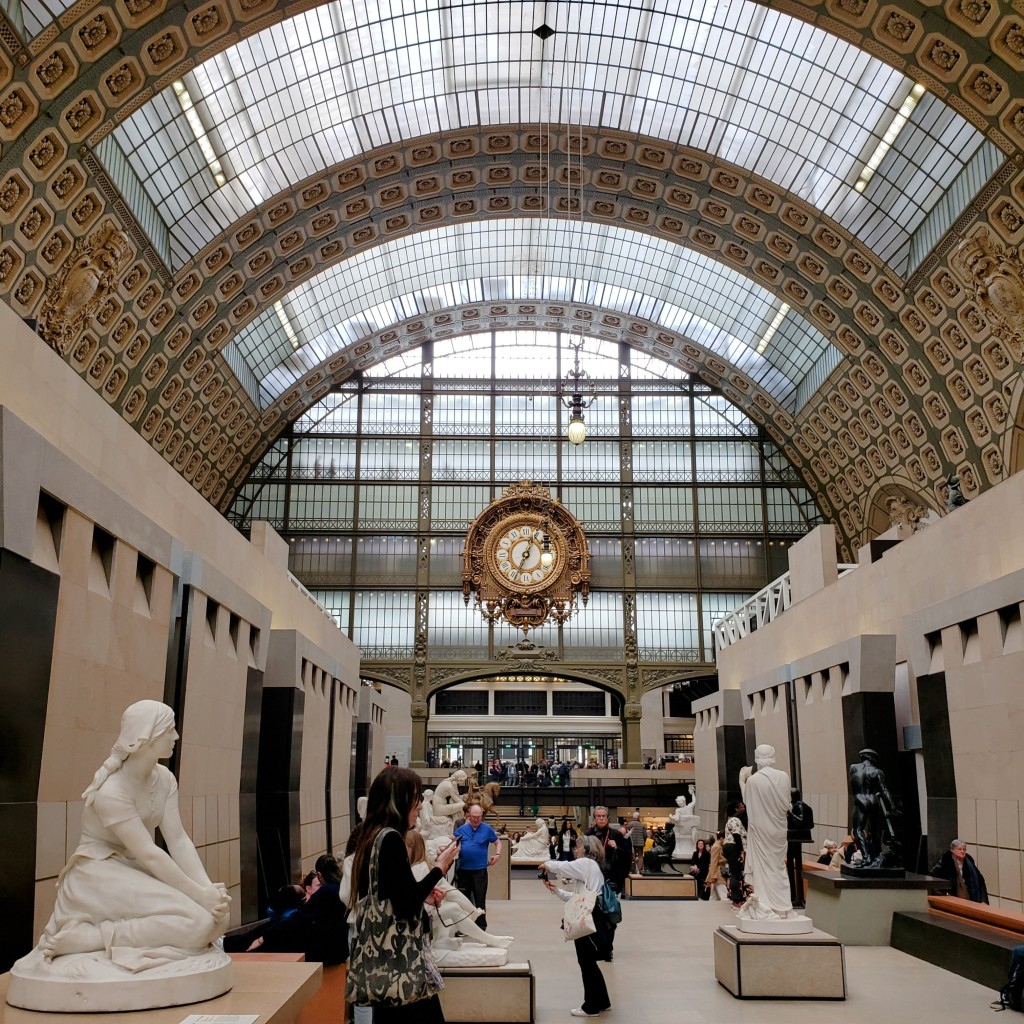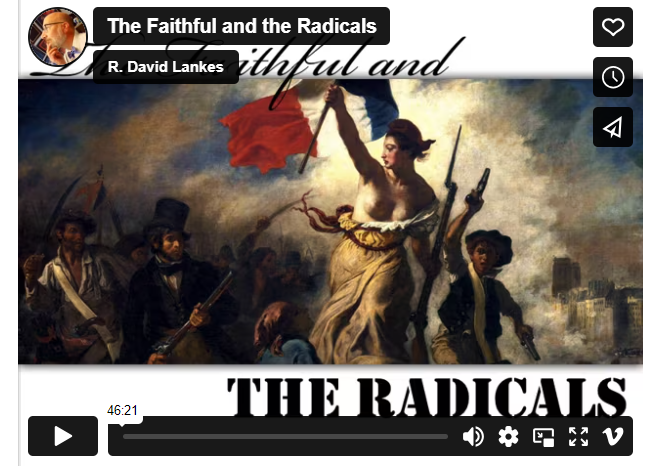There are angels, angels everywhere, in Paris. At least, that’s the impression I have while reading Rosemary Flannery’s charmingly engaging book Angels of Paris: An Architectural Tour Through the History of Paris and sinking into her numerous sensual photographs accompanying her text, long before arriving here a couple of weeks ago. But after walking around for several days looking for them in public spaces and on buildings, I realize how much time and effort Flannery spent seeking them out. Photographing them. Researching them in a variety of local libraries. Writing about them. And sharing them with locals as well as with readers all over the world through her book and through some of the interviews she has done. Because, as our second week in Paris begins, three of us (my wife, a friend, and I) meet her in the Place Saint-Michel to begin a private three-hour Angels of Paris walking tour with her as rain softens the already luminescent streets of Paris.
She is the consummate teacher/trainer/learner. She loves her subject and, more importantly, loves opening that subject up to others by immersing them in her world. It would be one thing for the three of to stand there in the Place Saint-Michel with a copy of her book, comparing the lovely photograph to the large-scale figure of Saint Michael standing before us on the vanquished, writhing Lucifer above the flowing water of the fountain which the bronze statue dominates. It’s quite another to realize nearly half an hour passes unnoticed with us standing there captivated, enraptured, and engaged as she sets the context for the tour by talking with us—not at us—about the angel, the history of that lovely work of art, the architectural setting that makes the experience of spending time with that particular angel something extending beyond awareness of the passage of time—all the while, word by wondrous word, drawing us into the world inhabited by this and other angels. This is interactive learning—learning at its best. A reminder of what we should attempt to create and recreate each we enter a sacred space of learning with those who are our co-conspirators in the learning process. Comprised of interplays of questions, comments. Exchanges as lovely and as conversational as a piece of chamber music in which each player uses a specific instrument to create something so tightly intertwined that, while it is happening, it seems without beginning and without end. As focused on us as on what we are exploring. And, ultimately, memorable. Transformative. Leaving us hungry for even more.
As we leave Place Saint-Michel and meander through the narrow streets of Paris’s Latin Quarter in search of other angels, Flannery employs the art of storytelling to further draw us in. Not just telling us about the beautiful cherubic angel carved into the architectural element above the door to a home once owned by someone who sent many to their deaths—the “Executioner’s Angel.” Or the angels encircling the spire above Sainte-Chapelle. Or those that are part of the oldest public clock in Paris, in the tower of the Conciergerie. She leavens this immersive learning experience with some of the stories behind how she researched and wrote the book. Carrying around a ladder so she could stand in just the right position to capture precisely the photograph she knew she had to capture. Wearing a dark coat that apparently made her so distinctive that one passerby asked her, as she was photographing yet another angel, whether she were a spy.
It doesn’t take me long to realize we are engaged in far more than an art and architecture tour. Flannery herself, acknowledging the sense she has of the angels in her life, rekindles in me a long-held belief that we are, nearly every day, surrounded by unnoticed angels. Those who seeing us about to step into the path of an oncoming automobile, gently pull us back, then vanish into a crowd as if they were never there. Those who see us struggling to find change while purchasing something in a local shop, reach into their own pockets, pull out a coin to make up for what we temporarily lack, nod demurely, and are gone so quickly we barely have a chance to thank them. Those who free us from an ersatz escape room. Or fix a lens that has popped out of the frame of our glasses. Or liberate trapped luggage from a locked, unmoving elevator. Or offer us sanctuary when we unexpectedly find ourself in the middle of a large-scale political demonstration. Those who attend the onsite and online classes that we facilitate, set aside their fears and trepidations, and engage so completely with what we are all doing that they make the learning experience far more deep, far richer, than it would have been without their presence. Those who come to us for mentoring, spend precious time with us ostensibly seeking guidance and support, and then return to what they were doing, having given us far more than we could ever give to them.
The tour, as planned, ends after three hours, but the conversation continues over lunch in a restaurant so full of life that I can’t help but suspect that angels are working in the kitchen. Flannery, the three of us who took the tour, and another friend who joins us for the meal linger as long as possible, overseen by whatever angels conspired to bring us all together. And when she finally has to leave to prepare for another tour late in the day, we trust our angels to continue to protect us and to guide as we wander aimlessly for another hour or two. Learning. Absorbing. Finding angelic inspiration all around us in and above the streets of Paris. And through continuing conversation cultivated on the wings of angels.
NB: This is the eighth in a series of reflections on traveling and learning in Paris.







 Posted by paulsignorelli
Posted by paulsignorelli 

















 But this was that wonderful moment when, for the first time since the COVID pandemic radically altered the way we all work, we were shoulder to shoulder in an onsite setting with a group of dynamic learners who were also relishing the opportunity to be off camera and physically (rather than virtually) together. There were plenty of tongue-in-cheek comments about how strange it was to be seeing each other’s faces without having those faces framed by the all-too-familiar Zoom boxes that provide us with (cherished) opportunities to interact online. And there was also the not-unexpected attention we continue to give to safety protocols—including those ubiquitous N95 masks so many of us continue to wear in a dual effort to avoid unintentionally spreading COVID or to contract it from unsuspecting carriers of the virus.
But this was that wonderful moment when, for the first time since the COVID pandemic radically altered the way we all work, we were shoulder to shoulder in an onsite setting with a group of dynamic learners who were also relishing the opportunity to be off camera and physically (rather than virtually) together. There were plenty of tongue-in-cheek comments about how strange it was to be seeing each other’s faces without having those faces framed by the all-too-familiar Zoom boxes that provide us with (cherished) opportunities to interact online. And there was also the not-unexpected attention we continue to give to safety protocols—including those ubiquitous N95 masks so many of us continue to wear in a dual effort to avoid unintentionally spreading COVID or to contract it from unsuspecting carriers of the virus. It doesn’t, however, end there. The shoulder-to-shoulder interactions extended into conversations on the conference exhibits-hall floor, moved outdoors as some of us took our lunches into the plaza outside the conference center so we could unmask and enjoy lunch and extended conversations. And, as always happens in these conference settings where friends and colleagues are unexpectedly waiting for us right around the corner, the conversations became richer and deeper as friends stumbled upon long-unseen friends and picked up right where they/we had left off.
It doesn’t, however, end there. The shoulder-to-shoulder interactions extended into conversations on the conference exhibits-hall floor, moved outdoors as some of us took our lunches into the plaza outside the conference center so we could unmask and enjoy lunch and extended conversations. And, as always happens in these conference settings where friends and colleagues are unexpectedly waiting for us right around the corner, the conversations became richer and deeper as friends stumbled upon long-unseen friends and picked up right where they/we had left off.







